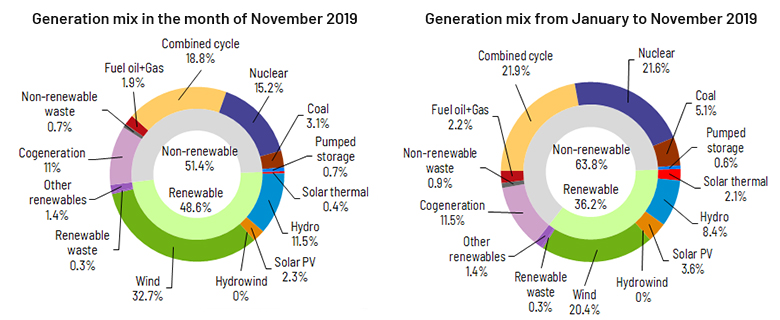Discover what Red Eléctrica is, what we do, and why we are the backbone of the electricity system in Spain and the ecological transition.
Demand for electricity in Spain falls by 0.4% in November
- 48.6% of the monthly generation came from renewable sources and 64.5% of the electricity generated was obtained using technologies which produce zero CO2 emissions.
- The demand for electricity increased by 5.3% in the Balearic Islands and by 1.1% in the Canary Islands when compared to the respective figures registered in November 2018.

The demand for electrical energy nationwide in the month of November was estimated at 21,966 GWh, a value that is 0.4% lower than that registered in the same month last year. After having factored in the influence of seasonal and working patterns, the demand for electricity fell 1.3% compared to November 2018.
In the first eleven months of 2019, the demand for electricity is estimated at 242,395 GWh, 1.7% less than in the same period in 2018. Again, after having factored in the influence of seasonal and working patterns, the demand for electricity is 2.7% lower than that registered in the same period last year.
During November and according to current estimated data, generation coming from renewable energy sources represented 48.6% of the total production. In the first eleven months of the year, renewable energy accounted for 36.2% of the total electricity generation mix nationwide.
64.5% of electricity generation during the month was obtained using technologies which produce zero CO2 emissions.
With information available as at the time of this press release, wind energy generation in November reached 7,396 GWh, a value 62.2% higher than in the same period last year, and accounted for 32.7% of the total production in Spain.

Demand for electrical energy in the peninsular electricity system falls by 0.6%
Demand for electrical energy in the peninsular electricity system in the month of November is estimated at 20,785 GWh, 0.6% lower than that recorded in the same month last year. After having factored in the influence of seasonal and working patterns, the demand for electricity fell by 1.5% compared to November 2018.
In the first eleven months of 2019, the demand for electricity on the Spanish Peninsula is estimated at 228,199 GWh, 1.8% less than in 2018. Again, after having factored in the influence of seasonal and working patterns, the demand for electricity is 2.9% lower than that registered in the same period last year.
During November and according to current estimated data, 50.4% of the peninsular generation came from renewable energy sources and 67.1% was obtained using technologies which produce zero CO2 emissions. Furthermore, wind energy in November stood at 7,271 GWh, a figure that is 60.6% higher than in November last year and contributed 33.8% to the generation mix.
Demand for electricity increases in the Balearic Islands and Canary Islands in November
In the Balearic Islands, the demand for electricity in November is estimated at 417,576 MWh, a value that is 5.3% higher than that recorded in the same month last year. After having factored in the influence of seasonal and working patterns, the figure increased by 1.7% with respect to November 2018. In the first eleven months of 2019, the demand on the Balearic Islands is estimated at 5,696,317 MWh, which is 1.1% more than in the same period in 2018.
Coal-fired generation, with 41.4% of the total, was the leading source of electricity generation in the Balearic Islands. Renewables and those technologies that produce zero CO2 emissions accounted for 6.2% of the total generation on the Balearic Islands.
Regarding the Canary Islands, demand for electricity is estimated at 728,677 MWh, 1.1% up on that registered in November 2018. After having factored in the influence of seasonal and working patterns, the figure is up 1.3% compared to that of the same month last year. From January to November, demand on the Canary Islands is estimated at 8,116,569 MWh, showing an increase of 0.2% compared to the same period in 2018.
In the month of November and according to estimated data, combined cycle was the leading technology in the Canary Islands’ generation mix, with a contribution of 32.2%. Renewables and those technologies that produce zero CO2 emissions accounted for 19.2% of the generation on the Canary Islands.
Consult our Daily Balance Report for more information on the National, Peninsular, Balearic Islands and Canary Islands electricity systems as at the close of November.











